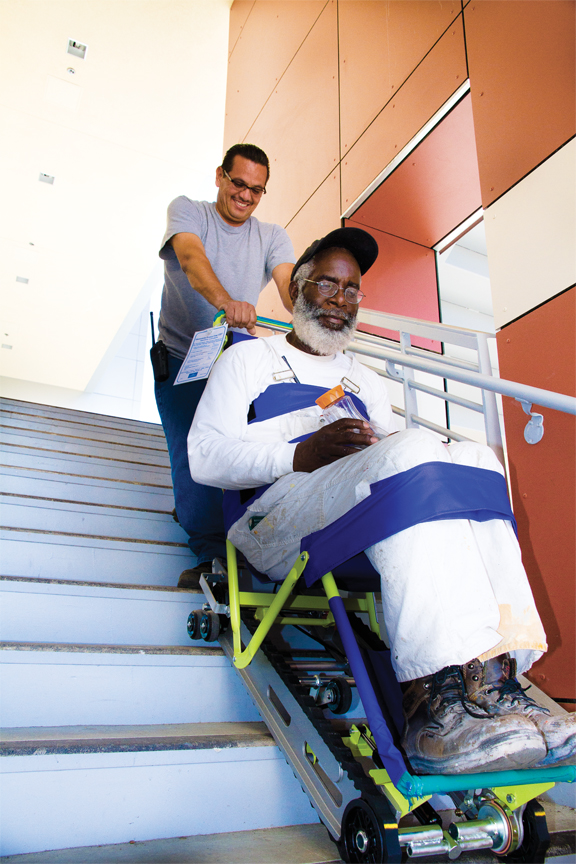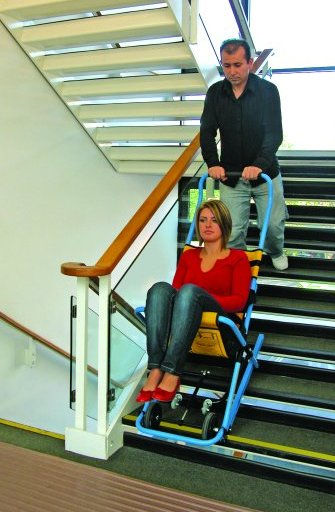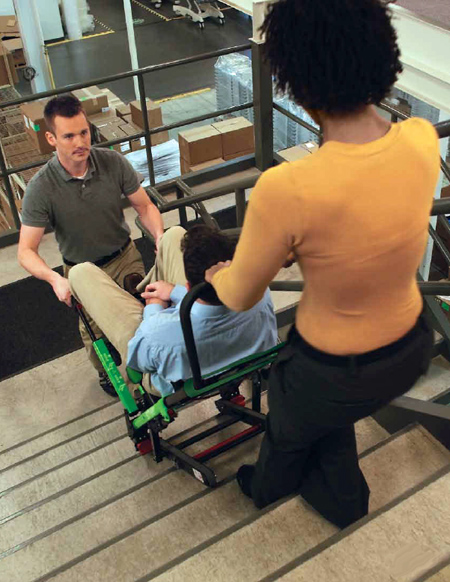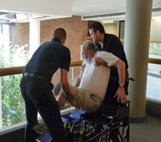Chapter 2 BUILDING AN EVACUATION PLAN FOR A PERSON WITH LIMITED MOBILITY
OCCUPANT NOTIFICATION SYSTEMS
No Special Requirements. People with limited mobility can hear standard alarms and voice announcements and can see activated visual notification appliances (strobe lights) that warn of danger and the need to evacuate. No additional planning or special accommodations for this function are required.
Is There a Usable Circulation Path?
A circulation path is considered a usable circulation path if it meets one of the following criteria:
-
A person with disabilities is able to travel unassisted through it to a public way.
-
A person with disabilities is able to travel unassisted through that portion of the circulation path necessary to reach an area of refuge.
An area of refuge serves as a temporary haven from the effects of a fire or other emergency. A person with a severe mobility impairment must have the ability to travel from the area of refuge to the public way, although such travel might depend on the assistance of others. If elevation differences are involved, an elevator or other evacuation device might be used, or others might move the person by using a wheelchair carry on the stairs.

Special Note 1
People with limited mobility need to know if there is a usable circulation path from the building they are in. If there is not a usable circulation path, then their plans will require alternative routes and methods of evacuation to be put in place.
Which Circulation Paths Are Usable Circulation Paths?
Exits, other than main exterior exit doors that obviously and clearly are identifiable as exits, should be marked by approved signs that are readily visible from any direction of approach in the exit access.
Where not all circulation paths are usable by people with disabilities, the usable circulation path(s) should be clearly identified by the international symbol of accessibility:

Locations of exit signs and directional exit signs are specified by model codes. Usually the signs are placed above exit doors and near the ceiling.
Supplemental directional exit signs may be necessary to clearly delineate the route to the exit. Exit signs and directional exit signs should be located so they are readily visible and should contrast against their surroundings.
Special Note 2
People with limited mobility should be provided with some form of written directions, a brochure, or a map showing all directional signs to all usable circulation paths. For new employees and other regular users of the facility it may be practical to physically show them the usable circulation paths as well as provide them with written information. In addition, simple floor plans of the building that show the locations of and routes to usable circulation paths should be available and given to visitors with limited mobility when they enter the building. A large sign could be posted at each building entrance stating the availability of written directions or other materials and where to pick them up. Building security personnel, including those staffing entrance locations, should be trained in all the building evacuation systems for people with disabilities and be able to direct anyone to the nearest usable circulation path.
Which Paths Lead to Usable Circulation Paths?
Any circulation paths that are not usable should include signs directing people to other, usable paths. People with limited mobility should be provided with written directions, a brochure, or a map showing what those signs look like and where they are.
Special Note 3
Where such directional signs are not in place, people with limited mobility should be provided with written directions, a brochure, or a map showing the locations of all usable circulation paths.
Can People with Limited Mobility Use the Usable Circulation Path by Themselves?
Is There a Direct Exit to Grade (or a Ramp)?
A circulation path is considered a usable circulation path if it meets one of the following criteria:
-
A person using a wheelchair is able to travel unassisted through it to a public way (if elevation differences are involved, there are usable ramps rather than stairs).
-
A person using a wheelchair is able to travel unassisted through that portion of the usable circulation path necessary to reach an area of refuge.
An area of refuge serves as a temporary haven from the effects of a fire or other emergency. People with limited mobility must be able to travel from the area of refuge to the public way, although such travel might depend on the assistance of others. If elevation differences are involved, an elevator or other evacuation device might be used, or the person might be moved by another person or persons using a cradle carry, a swing (seat) carry, or an in-chair carry. Training, practice, and an understanding of the benefits and risks of each technique for a given person are important aspects of the planning process.
Special Note 4
Not all people using wheelchairs or other assistive devices are capable of navigating a usable circulation path by themselves. It is important to verify that each person using any assistive device can travel unassisted through the usable circulation path to a public way. Those who cannot must have the provision of appropriate assistance detailed in their emergency evacuation plans. Additionally, the plans should provide for evacuation of the device or the availability of an appropriate alternative once the person is outside the building. Otherwise, the person with limited mobility will no longer have independent mobility once he or she is out of the emergency situation.
Can the Person with Limited Mobility Use Stairs?
Not all people with limited mobility use wheelchairs. Some mobility limitations prevent a person from using building features that require the use of one’s arms, hands, fingers, legs, or feet. People with limited mobility may be able to go up and down stairs easily but have trouble operating door locks, latches, and other devices due to impairments of their hands or arms. The evacuation plans for these people should address alternative routes, alternative devices, or specific provisions for assistance. Are there devices to help people with limited mobility evacuate?
Can the Elevators Be Used?
Although elevators can be a component of a usable circulation path, restrictions are imposed on the use of elevators during some types of building emergencies. Elevators typically return to the ground floor when a fire alarm is activated and can be operated after that only by use of a “fire fighters” keyed switch. This may not be true in the event of non-fire emergencies requiring an evacuation. In the last several years, however, building experts have increasingly joined forces to carefully consider building elevators that are safer for use in the event of an emergency.
In October 2003, the National Institute of Standards and Technology (NIST) began working with the elevator industry to develop and test more reliable emergency power systems and waterproof components. Under consideration are software and sensing systems that adapt to changing smoke and heat conditions, helping to maintain safe and reliable elevator operation during fire emergencies. Such changes could allow remote operation of elevators during fires, thus freeing fire fighters to assist in other ways during an emergency.
The topic was further examined in 2010 during the Workshop on the Use of Elevators in Fires and Other Emergencies cosponsored by the American Society of Mechanical Engineers (ASME International), NIST, the International Code Council (ICC), the National Fire Protection Association (NFPA), the U.S. Access Board, and the International Association of Fire Fighters (IAFF). The workshop provided a forum for brainstorming and formulating recommendations in an effort to improve codes and standards.
The majority of recommendations led to the formation of two new ASME task groups: the Use of Elevators by Fire Fighters task group and the Use of Elevators for Occupant Egress task group, and new code requirements. This work was a collaborative effort of ASME, NIST, ICC, NFPA, IAFF, the U.S. Department of Homeland Security (DHS), and the U.S. Access Board.
Here again, good planning and practice are key elements of a successful evacuation.
Are Lifts Available?
Lifts generally have a short vertical travel distance, usually less than 10 feet, and therefore can be an important part of an evacuation. Lifts should be checked to make sure they have emergency power, can operate if the power goes out, and if so, for how long or how many uses. It is important to know whether the building’s emergency power comes on automatically or a switch or control needs to be activated.
What Other Devices Are Available?
Some evacuation devices and methods, including stair-descent devices, require the assistance of others.
Who Will Provide the Assistance?
Anyone in the Office or Building
People with limited mobility who are able to go up and down stairs easily but have trouble operating door locks, latches, and other devices due to limitations of their hands or arms can be assisted by anyone. A viable plan to address this situation may be for the person with the disability to be aware that he or she will need to ask someone for assistance with a particular door or a particular device. It is important to remember that not everyone in a building is familiar with all the various circulation paths everywhere in the building and that they may have to use an unfamiliar one in the event of an emergency.
Specific Person(s) in the Office or Building
-
Friend or coworker
-
Relative
-
Supervisor
-
Building staff
-
Floor safety warden
-
-
First responders
-
Floor safety warden
-
Fire fighter
-
Police officer
-
Emergency medical services: emergency medical technicians (EMTs), ambulance personnel
-
How Many People Are Necessary to Provide Assistance?
One Person
When only one person is necessary to assist a person with limited mobility , a practical plan should identify at least two, ideally more, people who are willing and able to provide assistance. Common sense tells us that a specific person may not be available at any given time due to illness, vacation, an off-site meeting, and so on. The identification of multiple people who are likely to have different working and traveling schedules provides a more reliable plan.
Multiple People
When more than one person is necessary to assist a person with limited mobility, a practical plan should identify at least twice the number of people required who are willing and able to provide assistance. Common sense tells us that one or more specific people may not be available at any given time due to illness, vacation, off-site meetings, and so on. The identification of a pool of people who are likely to have different working and traveling schedules provides a more reliable plan.
What Assistance Will the Person(s) Provide?
Guidance
-
Explaining how and where the person needs to go to get to the usable circulation path
-
Escorting the person to and/or through the usable circulation path
Minor Physical Effort
-
Offering an arm to assist the person to/through the usable circulation path
-
Opening the door(s) in the usable circulation path
Major Physical Effort
-
Operating a stair-descent device
-
Participating in carrying a wheelchair down the stairs
-
Carrying a person down the stairs
Waiting for First Responders
Waiting with the person with limited mobility for first responders would likely be a last choice when there is an imminent threat to people in the building. While first responders do their best to get to a site and the particular location of those needing their assistance, there is no way of predicting how long any given area will remain a safe haven under emergency conditions.
This topic should be discussed in the planning stage. Agreement should be reached regarding how long the person giving assistance is expected to wait for the first responders to arrive. Such discussion is important because waiting too long can endanger more lives. If someone is willing to delay his or her own evacuation to assist a person with limited mobility in an emergency, planning how long that wait might be is wise and reasonable.
Where Will the Person(s) Start Providing Assistance?
From the Location of the Person Requiring Assistance
Does the person providing assistance need to go where the person with limited mobility is located at the time the alarm sounds? If so, how will he or she know where the person needing assistance is?
-
Face to face
-
Phone
-
PDA
-
E-mail
-
Visual
-
Other
From a Specific, Predetermined Location
-
Entry to stairs
-
Other
When Will the Person(s) Provide Assistance?
-
Always
-
Only when asked
-
Other
How Will the Person(s) Providing Assistance Be Contacted?
-
Face to face
-
Phone
-
PDA
-
E-mail
-
Visual
-
Other









User Comments/Questions
Add Comment/Question